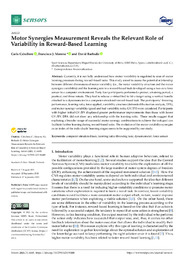Por favor, use este identificador para citar o enlazar este ítem:
https://hdl.handle.net/11000/34260Registro completo de metadatos
| Campo DC | Valor | Lengua/Idioma |
|---|---|---|
| dc.contributor.author | Caballero, Carla | - |
| dc.contributor.author | Moreno, Francisco Javier | - |
| dc.contributor.author | Barbado, David | - |
| dc.contributor.other | Departamentos de la UMH::Ciencias del Deporte | es_ES |
| dc.date.accessioned | 2025-01-10T09:04:26Z | - |
| dc.date.available | 2025-01-10T09:04:26Z | - |
| dc.date.created | 2021 | - |
| dc.identifier.citation | Sensors | es_ES |
| dc.identifier.issn | 1424-8220 | - |
| dc.identifier.uri | https://hdl.handle.net/11000/34260 | - |
| dc.description.abstract | Currently, it is not fully understood how motor variability is regulated to ease of motor learning processes during reward-based tasks. This study aimed to assess the potential relationship between different dimensions of motor variability (i.e., the motor variability structure and the motor synergies variability) and the learning rate in a reward-based task developed using a two-axis force sensor in a computer environment. Forty-four participants performed a pretest, a training period, a posttest, and three retests. They had to release a virtual ball to hit a target using a vertical handle attached to a dynamometer in a computer-simulated reward-based task. The participants’ throwing performance, learning ratio, force applied, variability structure (detrended fluctuation analysis, DFA), and motor synergy variability (good and bad variability ratio, GV/BV) were calculated. Participants with higher initial GV/BV displayed greater performance improvements than those with lower GV/BV. DFA did not show any relationship with the learning ratio. These results suggest that exploring a broader range of successful motor synergy combinations to achieve the task goal can facilitate further learning during reward-based tasks. The evolution of the motor variability synergies as an index of the individuals’ learning stages seems to be supported by our study | es_ES |
| dc.format | application/pdf | es_ES |
| dc.format.extent | 12 | es_ES |
| dc.language.iso | eng | es_ES |
| dc.publisher | MDPI | es_ES |
| dc.relation.ispartofseries | 21 | es_ES |
| dc.relation.ispartofseries | 19 | es_ES |
| dc.rights | info:eu-repo/semantics/openAccess | es_ES |
| dc.rights | Attribution-NonCommercial-NoDerivatives 4.0 Internacional | * |
| dc.rights.uri | http://creativecommons.org/licenses/by-nc-nd/4.0/ | * |
| dc.subject | computer simulated task | es_ES |
| dc.subject | learning ratio | es_ES |
| dc.subject | throwing task | es_ES |
| dc.subject | dynamometer | es_ES |
| dc.subject | force sensor | es_ES |
| dc.subject.other | CDU::7 - Bellas artes::79 - Diversiones. Espectáculos. Cine. Teatro. Danza. Juegos.Deportes | es_ES |
| dc.title | Motor Synergies Measurement Reveals the Relevant Role of Variability in Reward-Based Learning | es_ES |
| dc.type | info:eu-repo/semantics/article | es_ES |
| dc.relation.publisherversion | https://doi.org/10.3390/s21196448 | es_ES |

Ver/Abrir:
2021_JCR_17_Sensors_Motor Synergies Measurement Reveals the Relevant Role of.pdf
1,37 MB
Adobe PDF
Compartir:
 La licencia se describe como: Atribución-NonComercial-NoDerivada 4.0 Internacional.
La licencia se describe como: Atribución-NonComercial-NoDerivada 4.0 Internacional.
.png)